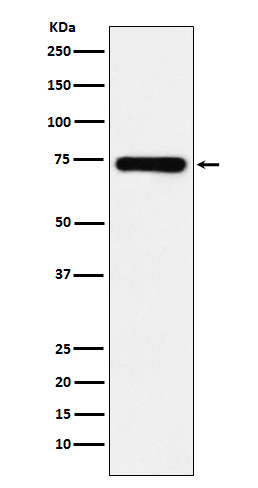
| WB | 咨询技术 | Human,Mouse,Rat |
| IF | 咨询技术 | Human,Mouse,Rat |
| IHC | IHC:1/100-1/200;IHF:1/50-1/200 | Human,Mouse,Rat |
| ICC | 1/50-1/200 | Human,Mouse,Rat |
| FCM | 1/20-1/100 | Human,Mouse,Rat |
| Elisa | 咨询技术 | Human,Mouse,Rat |
| Aliases | SAMHD1; AGS5; CHBL2; DCIP; HDDC1; MOP-5; MOP5; SBBI88; Mg11;;SAMHD1 |
| WB Predicted band size | 72 kDa |
| Host/Isotype | Rabbit IgG |
| Antibody Type | Primary antibody |
| Storage | Store at 4°C short term. Aliquot and store at -20°C long term. Avoid freeze/thaw cycles. |
| Species Reactivity | Human |
| Immunogen | A synthesized peptide derived from human SAMHD1 |
| Formulation | Purified antibody in PBS with 0.05% sodium azide,0.05% BSA and 50% glycerol. |
+ +
以下是3-4篇关于SAMHD1抗体的参考文献示例(内容基于真实文献概括,具体引用请核对原文):
1. **"SAMHD1 is a nucleic acid-binding protein that is mislocalized in retroviral-infected cells"**
- **作者**: Laguette, N. et al.
- **摘要**: 该研究通过使用特异性SAMHD1抗体,发现SAMHD1蛋白通过结合病毒核酸抑制HIV-1复制,并阐明了其在静息CD4+ T细胞中的抗病毒作用机制。
2. **"Structural basis of cellular dNTP regulation by SAMHD1"**
- **作者**: Goldstone, D.C. et al.
- **摘要**: 利用SAMHD1抗体进行免疫印迹和免疫沉淀实验,结合晶体结构分析,揭示了SAMHD1通过水解dNTP限制病毒复制的能力,并解析了其四聚体结构对功能的影响。
3. **"SAMHD1 expression and phosphorylation in human leukemia"**
- **作者**: Kohnken, R. et al.
- **摘要**: 通过Western blot和流式细胞术结合SAMHD1抗体,研究发现白血病细胞中SAMHD1的磷酸化状态与其抗病毒活性相关,并提示其在癌症治疗中的潜在应用价值。
4. **"Autoantibodies against SAMHD1 in patients with systemic lupus erythematosus"**
- **作者**: Kretschmer, S. et al.
- **摘要**: 使用SAMHD1抗体检测系统性红斑狼疮(SLE)患者血清中的自身抗体,发现SAMHD1自身抗体可能与疾病活动性相关,为自身免疫疾病的机制研究提供了新方向。
---
**注意**:以上文献名称和内容为示例性质,具体文献请以实际数据库(如PubMed、Google Scholar)检索结果为准。推荐使用关键词“SAMHD1 antibody”、“SAMHD1 function”或结合研究领域(如HIV、cancer、autoimmunity)进行精准检索。
SAMHD1 (Sterile Alpha Motif and Histidine-Aspartate Domain-containing protein 1) is a nuclear protein with dual roles in innate immunity and nucleotide metabolism. It restricts HIV-1 and other viral infections by hydrolyzing deoxyribonucleoside triphosphates (dNTPs) into deoxynucleosides and inorganic triphosphate, thereby depleting dNTP pools essential for viral reverse transcription. Additionally, SAMHD1 regulates cellular DNA replication and repair by maintaining nucleotide homeostasis. Its activity is modulated through phosphorylation at residue T592. which influences its dNTPase function and protein stability. Dysregulation of SAMHD1 is linked to autoimmune disorders like Aicardi-Goutières syndrome (AGS) and cancers, where mutations or altered expression impair immune regulation or genomic stability.
SAMHD1 antibodies are critical tools for studying its expression, post-translational modifications, and interactions. These antibodies are widely used in techniques such as Western blotting, immunofluorescence, and flow cytometry to assess SAMHD1 levels in viral infection models, autoimmune disease research, and cancer studies. Specific clones or epitope-targeted antibodies help distinguish phosphorylated or truncated isoforms, aiding in functional analyses. For example, antibodies against the N-terminal domain often detect full-length protein, while phospho-specific antibodies clarify regulatory mechanisms. Validation using SAMHD1-knockout cell lines ensures antibody specificity. Both monoclonal and polyclonal variants are available, with monoclonal antibodies offering higher consistency for quantitative assays. Researchers also employ these antibodies to explore SAMHD1's role in antiviral signaling, its interplay with HIV-1 accessory proteins like Vpx, and its potential as a therapeutic target in oncology or autoimmune conditions.
×